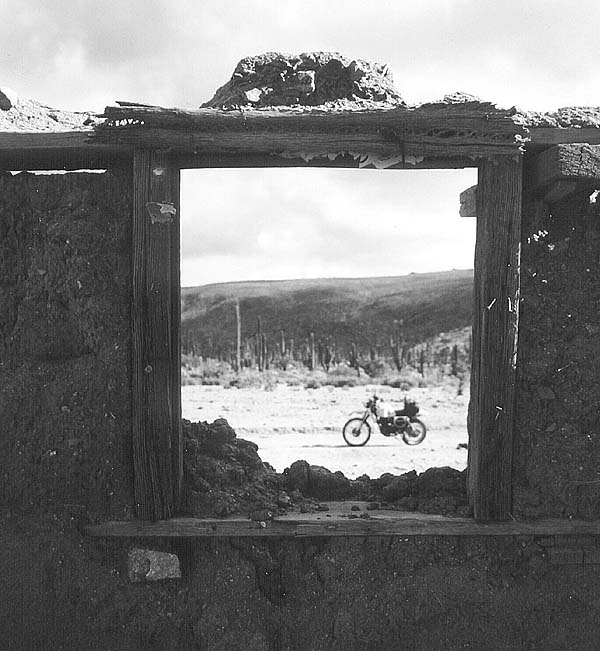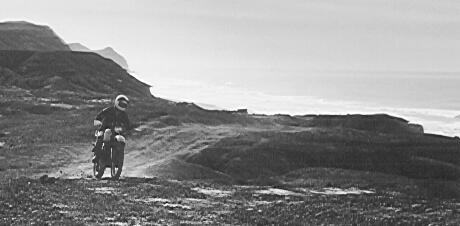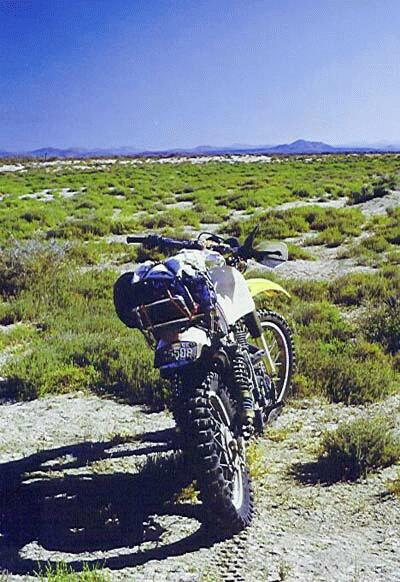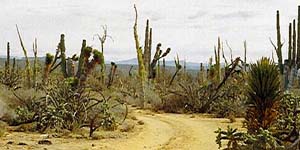 |
 |
InflatablesMagdalena 
In retrospect I suppose that some of these adventures stretched our common sense somewhat, but common sense is the Jewish Mother of adventure, and so we often left a little bit of normal caution behind in the trousers of our workday clothes.Take for example the voyage to check out an island in Magdalena Bay. It came about after my reading about an old whaling station that had been located there. The place even appeared on contemporary nautical charts as an artifact. According to the book, The Flight of the Least Petrel, there was supposed to be a huge pile of old whale bones visible from far out in the bay. Well, the book was written in the thirties, and most whale bones left on a beach in Baja will start to noticeably crumble after about a year or two. So we didn't find any bones, but we did come upon some of the old boilers and parts of ships of the era. Nowadays the place is on the itinerary for commercial kayak trip vendors. There is a sidebar story for another time about how we ended up hiring a boat to take us out to that island, and it involved a local character from Puerto San Carlos who had been stung by the barb of a stingray a few days earlier. But that is another story.
On the way back from that visit, we searched out a way to ride the bikes from the inland road out over the barrier dunes to the beach, in hopes of some mechanized beachcombing. But there on the Magdalena plain dwells a critter you have to watch out for. He only lives in that part of the world. They call him the Creeping Devil Cactus
Your Mileage May Differ
Now, everybody seems to have a different perspective about Baja. That includes those who have never been there and prize their sources, as well as those who have and are often possessed by tightly held notions derived from superficial observations. The people are this way, the animals that way, the weather is such and such. As in the parable about the six blind men and the elephant, the part of the place that you touch and your prior convictions help shape what you will later say that Baja is and isn't. Well, no generalization is worth a damn, as they say. It is amusing to read contemporary American naturalist writers who fawn all over the territory but can't quite get the locations and place names right. Even if you speak the language like a colono, all you can do is collect a small set of impressions that are comfortably couched in your predispositions. You can go with a guided fishing or kayaking tour, a superficial and air-conditioned drive, a humanitarian gesture, a flight to Cabo, a work or study assignment. And when you come back you'll probably be just as boringly opinionated and unidimensional as this web page.

On the lookout for the Creeping Devil cactus, near Bahía Magdalena.
Scott and the Snake
Take that old saw about "leave the animals alone and they will leave you alone." Scott evidently used to believe it, until he met Brer Rattlesnake. One day out on the Vizcaíno peninsula he (Scott, not the snake) was riding down a trail and noticed a retreating rattlesnake, believing all that while that it was just going to let him pass, no problema. But no, it changed course from slithering away to attack mode and came back at him, narrowly missing Scott. The next time I saw him he was sitting on top of a boulder the size of a fortress. I think it was on the same trip that we found a scorpion under our gear one morning. For those disposed to folklore, I am told that the alacranes, the scorpions, kill more people in Mexico than the snakes.The Confused Coyote
Just a few years prior to Scott's visit with the snake, I had my own little animal adventures. One of them involved another rattlesnake that refused to rattle. Another story involved a confused coyote. In that case, I was riding the XT500 on the main road near the turnoff for Bahiá de Los Angeles, in broad daylight. Suddenly, I caught something in the periphery of my vision, which nature graciously provided with the means for detecting fast-moving predators. It was a coyote, as the riders behind me can attest, running out of the roadside brush at full speed, right at me. Naturally, I immediately snapped the throttle wide open, at which time the coyote decided that catching me was probably out of the question, and he fell all over himself trying to get back into the brush before any other coyotes noticed how stupid he was.Well, I got my revenge on one of those coyotes later, but we won't talk about it right here.
Cactus Theory, Whale Legends.
There were a lot of interesting little forays we took over the years, often building upon the experiences and discoveries of folks who had been there long before the pavement and the resorts. Our own travels would thus seem comparatively mild, although not entirely free of the sort of risks you should anticipate in such desert places. Most of our visits into the bush had something to do with cactus, and you can probably guess what cholla spines can do to tires.

Creeping Devil cactus. It grows radially from a point, like a deadly terrestrial starfish.
Of course, it wasn't just the cholla. There were the tall cardan cactus, akin to the saguaro of the southwestern U.S., and the biznaga, or "fishhook" cactus, as well as the Creeping Devil cactus of the Magdalena plain. Then there were the cirio, also known to gringos as Boojum trees, which were neither trees nor cactus, but a distant relative of roses.But it was cholla that seemed to be as insidious as a Federal program. We used a great deal of tire sealant but in our quest for scientific legerdemain we contrived a hypothesis that there is a force in the universe analogous to magnetism that causes hydrocarbon-based tires to attract cactus spines. The hypothesis also states the force of the attraction is directly proportional to both the relative weakness of the tire and the distance from a vulcanizador. A corollary deals with the ability of the cholla to detect a hole in a glove.
Over a span of years we set out to collect whale bones. After a few difficult sessions finding our ways over the barrier dunes and other obstacles, we figured out how the currents sent whale carcasses onto likely beaches. And since the skeletons as we found them were just bones strewn over a large area, intermingled and incomplete, we got into a little ostiology study. The caudal vertebrae of a whale looked like little white paving stones. In time we were able to identify where the various bones belonged on the skeletons, and even the approximate age of the specimens. For that we relied on such works as The Marine Mammals of the Northwestern Coast of North America, by none other than the character whose name was given to one of the lagoons we frequented: Charles M. Scammon.
As far as how so many skeletons ended up on these beaches, we discovered that the killer whales (and some say the Great White sharks) wait for the less than fully capable whales that come out of the lagoons around early spring, perhaps a bit out of shape for seafaring after the warm and calm lagoons. And then that smarmy "balance of nature" stuff takes over.
According to some accounts, pods of killer whales attack the larger Gray whales as they leave the lagoons. Sometimes they take turns, biting into the Gray's flukes and holding them under water until they drown. Then they rip out the good parts, which is usually just the tongue, and leave the carcasses floating for the lesser animals. I guess in some sense we beachcombers were among the lesser animals.
Where we weren't supposed to be: A powerful rip offshore and a failing engine made it a bit of a challenge to get off this sand spit and back into Laguna Guerrero Negro.
Perhaps equally amazing is that nobody was ever clobbered by a stingray, which haunt the lagoons in enormous numbers and typically vote for PRI candidates in Mexican elections. And offshore a ways are the hammerhead sharks. We used second-hand Achilles boats instead of Zodiacs. (Zodiacs are what the rich environmentalist brats get to use). There were porpoises in the channels that thought it the apex of cetacean amusement to run up to the side of an inflatable and then breach in a sudden spray, scaring the daylights out of the crew, who thought that some sort of Mexican Moby Dick was at hand.
Another hat: Go to my website for the Colorado Army National Guard: here
| Go ahead. You tell
some stories. |